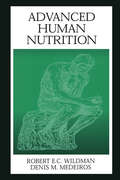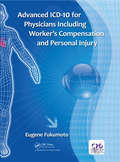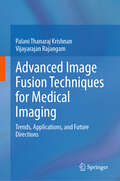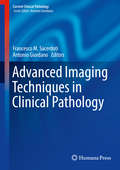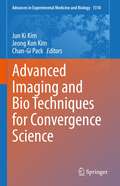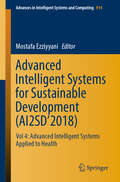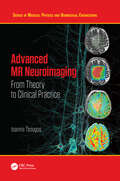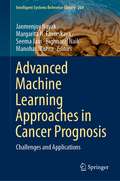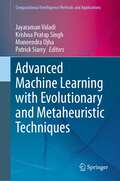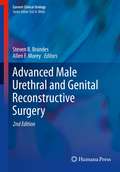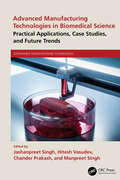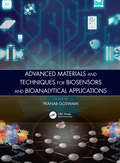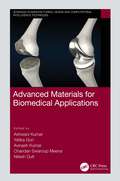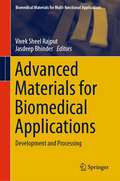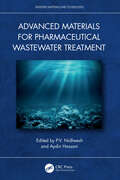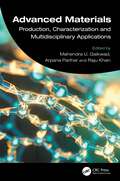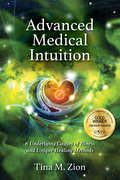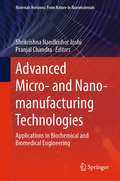- Table View
- List View
Advanced Human Nutrition (Modern Nutrition)
by Robert E.C. Wildman Denis M. MedeirosThis text begins with an in-depth overview into the human organism at the molecular, cellular, tissue and organ levels, and develops into a discussion of the objectives and features of organ systems of the evolved human. The book also covers the relationship between the human body and the environment in which it exists including other organisms tha
Advanced ICD-10 for Physicians Including Worker’s Compensation and Personal Injury
by Eugene FukumotoICD-10 is the 10th revision of the International Statistical Classification of Diseases and Related Health Problems (ICD), a medical classification list by the World Health Organization. It contains codes for diseases, signs and symptoms, abnormal findings, complaints, social circumstances, and external causes of injury of diseases. The code set allows more than 14,000 different codes and permits the tracking of many new diagnoses. The U.S. has used ICD-10-CM (Clinical Modification) since October, 2015. This national variant of ICD-10 was provided by the Centers for Medicare and Medicaid Services (CMS) and the National Center for Health Statistics, and the use of ICD-10-CM codes are now mandated for all inpatient medical reporting requirements. This book is for physicians, practice managers and all others who need learn ICD-10. It’s designed for the clinician to learn how to put their diagnosis into a code and not rely on staff or computer software programs to decide it form them. ICD-10 is a complex system of coding and Medicare and third party insurers have been lenient giving providers a year to get used to the coding system. As a result, physicians and their staff have become very complacent regarding proper coding. However, Medicare and third party insurers will soon begin to deny claims which are not coded correctly, which in turn will cost physician groups time and money. This book focuses on Worker’s Compensation and Personal Injury, a very large segment of the healthcare industry and is a new area to ICD-10. The diagnosis coding for injuries is much different than for Medicare or group insurance and unless the physicians and their staff learn how to use it properly, they risk losing income for themselves and worse, they risk losing the case for the patient.
Advanced IOL Fixation Techniques: Strategies for Compromised or Missing Capsular Support
by David F. ChangAbnormal or deficient capsular anatomy creates numerous surgical challenges and predisposes eyes to IOL complications. Literally dozens of different approaches have been devised to implant IOLs in the face of compromised capsular support. However, a comprehensive compendium of the most important surgical strategies has not existed, until now.Advanced IOL Fixation Techniques:Strategies for Compromised or Missing Capsular Support provides this much-needed resource with more than 70 different chapters that cover the wide array of surgical approaches. Among the contributors are many of the original innovators of the most important technologies and methodologies. In addition to teaching a specific surgical technique, these authors cover its history, rationale, and clinical results. Editor Dr. David F. Chang is well known and acclaimed for 2 best-selling cataract textbooks—Mastering Refractive IOLs and Phaco Chop and Advanced Phaco Techniques. Along with associate editors Drs. Bryan S. Lee and Amar Agarwal, Dr. Chang has now tackled this new major subject area—how to best fixate IOLs when capsular support is compromised or absent. Part One covers capsular fixation with either zonulopathy or following posterior capsule rupture. Topics include using conventional and modified capsular tension rings, capsular tension segments or capsular anchors, standard and reverse optic capture with anterior capsulorrhexis, sulcus fixation, posterior capsulorrhexis, and capsular membrane suture fixation. Part Two covers noncapsular fixation. Topics include anterior chamber IOLs, iris claw IOLs, iris and transscleral suture fixation of posterior chamber IOLs, and intrascleral haptic fixation using the Yamane double-needle or glued IOL methods. Part Three covers miscellaneous topics such as anterior vitrectomy, IOL power calculation for noncapsular IOLs, and sliding slip knots and suture pupilloplasty. To facilitate skills transfer, most chapters present detailed, step-by-step descriptions of the different techniques. The maneuvers are illustrated by over 1,100 diagrams and high-resolution surgical images. Finally, nearly every chapter is accompanied by narrated instructional videos. Combining over 150 videos, schematic diagrams, surgical images, and detailed written descriptions, Advanced IOL Fixation Techniques provides the most effective way to learn advanced surgical techniques. With its comprehensive and practical approach to covering the gamut of strategies and devices, Advanced IOL Fixation Techniques:Strategies for Compromised or Missing Capsular Support will be an indispensable resource for cataract surgeons at all levels of experience.
Advanced Image Fusion Techniques for Medical Imaging: Trends, Applications, and Future Directions
by Palani Thanaraj Krishnan Vijayarajan Rajangam"Advanced Image Fusion Techniques for Medical Imaging: Trends, Applications, and Future Directions" is a comprehensive exploration of cutting-edge image fusion methodologies in the realm of medical imaging. This timely work addresses the growing need for advanced techniques to integrate and analyze multi-modal medical images, offering healthcare professionals and researchers a valuable resource for improving diagnostic accuracy and patient outcomes. The book provides a thorough examination of both conventional and deep learning-based fusion strategies, covering a wide spectrum of applications in medical image processing. From noise reduction and image enhancement to segmentation and classification, the authors present a detailed analysis of how image fusion can be leveraged to overcome the limitations of individual imaging modalities. Real-world case studies and practical examples throughout the text demonstrate the tangible benefits of these techniques in clinical settings. Looking beyond current applications, this forward-thinking volume also explores emerging trends and future directions in medical image fusion. By addressing challenges and potential impacts on healthcare practices, the authors offer readers a glimpse into the future of medical imaging. This book serves as an essential guide for researchers in biomedical engineering, medical professionals specializing in radiology and medical imaging, and graduate students in computer science, electrical engineering, biomedical engineering. This diverse audience reflects the book's comprehensive approach to advanced image fusion techniques in medical imaging, covering both theoretical foundations and practical applications.
Advanced Imaging Techniques in Clinical Pathology (Current Clinical Pathology)
by Antonio Giordano Francesco M. SacerdotiThis text provides a comprehensive, state-of-the-art review of the application of image analysis focusing on the techniques which can be used in every biology and medical laboratory to automate procedures of cell analysis and to create statistics very useful for a comprehension of cell growth dynamics and the effects of drugs on them. This textbook will serve as a very useful resource for physicians and researchers dealing with, and interested in, cell analysis. It will provide a concise yet comprehensive summary of the current status of the field that will help guide patient management and stimulate investigative efforts. All chapters are written by experts in their fields and include the most up-to-date scientific and clinical information. Advanced Imaging Techniques in Clinical Pathology will be of great value to clinical pathologists, biologists, biology researchers, and those working in the clinical and biological laboratory arena.
Advanced Imaging and Bio Techniques for Convergence Science (Advances in Experimental Medicine and Biology #1310)
by Jun Ki Kim Jeong Kon Kim Chan-Gi PackThis book is a wide-ranging guide to advanced imaging techniques and related methods with important applications in translational research or convergence science as progress is made toward a new era in integrative healthcare. Conventional and advanced microscopic imaging techniques, including both non-fluorescent (i.e., label-free) and fluorescent methods, have to date provided researchers with specific and quantitative information about molecules, cells, and tissues. Now, however, the different imaging techniques can be correlated with each other and multimodal methods developed to simultaneously obtain diverse and complementary information. In addition, the latest advanced imaging techniques can be integrated with non-imaging techniques such as mass spectroscopic methods, genome editing, organic/inorganic probe synthesis, nanomedicine, and drug discovery. The book will be of high value for researchers in the biological and biomedical sciences or convergence science who need to use these multidisciplinary and integrated techniques or are involved in developing new analytical methods focused on convergence science.
Advanced Imaging and Therapy in Neuro-Oncology
by Luigi Mansi Egesta LopciThis book covers all diagnostic and therapeutic aspects of neuro-oncological diseases. In the last decade, the management of brain tumors has been revolutionized following the new WHO classification and thanks to the introduction of molecular markers into the clinical routine. From an imaging point of view, the continuous technological developments and the implementation of various radiopharmaceuticals have paved the way to new clinical indications and has helped optimize patient management. In this context, a major breakthrough could derive from the introduction of radiomics and artificial intelligence in the diagnostic and therapeutic pathway. Not forgetting the emerging role of heavy-ion therapy as a complement to the innovative drugs and treatments adopted in medical oncology and radiation therapy. In the present book, all above-mentioned aspects are covered, starting with the novel standards for the WHO classification of brain tumors, to the up-to-date surgical techniques and advanced therapeutic approaches, passing through the currently available imaging modalities and ongoing developments embracing both radiology and nuclear medicine discipline. Imaging represents indeed the “trait d'union” for all the arguments described in the book; therefore, in most chapters there are dedicated sessions focused on the role of imaging in each specific context. The publication aims to fill the gap between the clinicians and all professionals directly involved in the management of patients with brain tumors and the newest scientific outreach. Moreover, thanks to the comprehensive insight into the latest technological developments, scientists and researchers interested in the topic will find the book a useful tool for future studies and perspective discoveries.
Advanced Intelligent Systems for Sustainable Development: Vol 4: Advanced Intelligent Systems Applied to Health (Advances in Intelligent Systems and Computing #914)
by Mostafa EzziyyaniThis book gathers papers presented at the International Conference on Advanced Intelligent Systems for Sustainable Development (AI2SD-2018), which was held in Tangiers, Morocco on 12–14 July 2018. Highlighting the latest research and advances in the field of healthcare, it shares essential insights into the health sector, and is intended to stimulate further discussion and promote closer interdisciplinary collaboration among researchers and health professionals.
Advanced Intelligent Systems for Sustainable Development: Volume 5: Advanced Intelligent Systems for Computing Sciences (Advances in Intelligent Systems and Computing #915)
by Mostafa EzziyyaniThis book includes the outcomes of the International Conference on Advanced Intelligent Systems for Sustainable Development (AI2SD-2018), held in Tangier, Morocco on July 12–14, 2018. Presenting the latest research in the field of computing sciences and information technology, it discusses new challenges and provides valuable insights into the field, the goal being to stimulate debate, and to promote closer interaction and interdisciplinary collaboration between researchers and practitioners. Though chiefly intended for researchers and practitioners in advanced information technology management and networking, the book will also be of interest to those engaged in emerging fields such as data science and analytics, big data, internet of things, smart networked systems, artificial intelligence, expert systems and cloud computing.
Advanced Laser Surgery in Dentistry
by Georgios E. RomanosAdvanced Laser Surgery in Dentistry delivers a state-of-the-art reference for laser technology in the context of a dental practice. The book encompasses oral surgery, periodontology, and implant dentistry, covering the latest research, knowledge, and clinical practices. The author demonstrates the clinical relevance by including many real-world clinical cases that illustrate the application of the discussed techniques. The book includes high-quality, color photographs throughout to support the text and add visual information to the covered topics, which include wound healing, oral surgery, periodontology, implant dentistry, and laser fundamentals and safety considerations. Advanced Laser Surgery in Dentistry provides readers with a step-by-step guide for using lasers in dental practice and discusses likely new directions and possible future treatments in the rapidly advancing field of laser dentistry. Readers will also benefit from a wide variety of subjects, including: A thorough introduction to the fundamentals of lasers, including the beam, the laser cavity, active mediums, lenses, resonators, and delivery systems An exploration of lasers and wound healing, including soft tissue and bone healing, as well as laser-assisted excisions and osteotomies An analysis of lasers in periodontology, including laser-assisted bacteria reduction in the periodontal tissues and the removal of subgingival dental calculus A discussion of lasers in implant dentistry and treatment for peri-implantitis Perfect for oral and maxillofacial surgeons, periodontists, and implant dentists, as well as general dentists, Advanced Laser Surgery in Dentistry will also earn a place in the libraries of dental students and residents seeking to improve their understanding of laser-based oral and dental procedures with a carefully organized reference guide.
Advanced MR Neuroimaging: From Theory to Clinical Practice (Series in Medical Physics and Biomedical Engineering)
by Ioannis TsougosOver the last decade, some of the greatest achievements in the field of neuroimaging have been related to remarkable advances in magnetic resonance techniques, including diffusion, perfusion, magnetic resonance spectroscopy, and functional MRI. Such techniques have provided valuable insights into tissue microstructure, microvasculature, metabolism and brain connectivity. Previously available mostly in research environments, these techniques are now becoming part of everyday clinical practice in a plethora of clinical MR systems. Nevertheless, despite growing interest and wider acceptance, there remains a lack of a comprehensive body of knowledge on the subject, exploring the intrinsic complexity and physical difficulty of the techniques. This book focuses on the basic principles and theories of diffusion, perfusion, magnetic resonance spectroscopy, and functional MRI. It also explores their clinical applications and places emphasis on the associated artifacts and pitfalls with a comprehensive and didactic approach. This book aims to bridge the gap between research applications and clinical practice. It will serve as an educational manual for neuroimaging researchers and radiologists, neurologists, neurosurgeons, and physicists with an interest in advanced MR techniques. It will also be a useful reference text for experienced clinical scientists who wish to optimize their multi-parametric imaging approach.
Advanced Machine Learning Approaches in Cancer Prognosis: Challenges and Applications (Intelligent Systems Reference Library #204)
by Seema Jain Margarita N. Favorskaya Janmenjoy Nayak Bighnaraj Naik Manohar MishraThis book introduces a variety of advanced machine learning approaches covering the areas of neural networks, fuzzy logic, and hybrid intelligent systems for the determination and diagnosis of cancer. Moreover, the tactical solutions of machine learning have proved its vast range of significance and, provided novel solutions in the medical field for the diagnosis of disease. This book also explores the distinct deep learning approaches that are capable of yielding more accurate outcomes for the diagnosis of cancer. In addition to providing an overview of the emerging machine and deep learning approaches, it also enlightens an insight on how to evaluate the efficiency and appropriateness of such techniques and analysis of cancer data used in the cancer diagnosis. Therefore, this book focuses on the recent advancements in the machine learning and deep learning approaches used in the diagnosis of different types of cancer along with their research challenges and future directions for the targeted audience including scientists, experts, Ph.D. students, postdocs, and anyone interested in the subjects discussed.
Advanced Machine Learning with Evolutionary and Metaheuristic Techniques (Computational Intelligence Methods and Applications)
by Patrick Siarry Jayaraman Valadi Krishna Pratap Singh Muneendra OjhaThis book delves into practical implementation of evolutionary and metaheuristic algorithms to advance the capacity of machine learning. The readers can gain insight into the capabilities of data-driven evolutionary optimization in materials mechanics, and optimize your learning algorithms for maximum efficiency. Or unlock the strategies behind hyperparameter optimization to enhance your transfer learning algorithms, yielding remarkable outcomes. Or embark on an illuminating journey through evolutionary techniques designed for constructing deep-learning frameworks. The book also introduces an intelligent RPL attack detection system tailored for IoT networks. Explore a promising avenue of optimization by fusing Particle Swarm Optimization with Reinforcement Learning. It uncovers the indispensable role of metaheuristics in supervised machine learning algorithms. Ultimately, this book bridges the realms of evolutionary dynamic optimization andmachine learning, paving the way for pioneering innovations in the field.
Advanced Male Urethral and Genital Reconstructive Surgery (Current Clinical Urology)
by Steven B. Brandes Allen F. MoreySince the publication of the first edition of Urethral Reconstructive Surgery, important refinements have been added to the urologic surgical armamentarium. Extensively revised and updated, Advanced Male Urethral and Genital Reconstructive Surgery, Second Edition guides urologists in a practical manner on how to evaluate and manage complex urethral and male genital reconstructive challenges. Chapters have been added on wound healing, synchronous urethral strictures, non-transecting anastomotic urethroplasty (including muscle and vessel sparing), overlapping buccal grafts, male urethral slings, genital skin grafting, Peyronie's surgery, priapism, pediatric strictures and prosthetics. Such chapters greatly strengthen the overall appeal of the book. The volume closes with a new comprehensive appendix of preferred instruments. With broad contributions by international authorities in reconstructive urologic surgery, Advanced Male Urethral and Genital Reconstructive Surgery, Second Edition is a valuable resource for all urologists, from residents to reconstructive surgeons.
Advanced Manufacturing Technologies in Biomedical Science: Practical Applications, Case Studies, and Future Trends (Sustainable Manufacturing Technologies)
by Manpreet Singh Chander Prakash Hitesh Vasudev Jashanpreet SinghAs healthcare challenges such as human aging and traffic accidents continue to increase exponentially, the biomedical sector faces a significant obstacle in arranging patient-specific biomedical products. Over the past two decades, additive manufacturing’s printing quality and ease of production have gained global attention, particularly in the development of scaffolds and implants.This book explores additive manufacturing technologies and their categorization, materials, processing factors, output responses, advantages, challenges, and biomedical applications. It provides a critical analysis of past biomedical applications of additive manufacturing technology, explores recent advancements, and examines the design, applications, and characterizations of biomedical components using additive manufacturing techniques. Moreover, it discusses notable applications of additive fabrication in aerospace, education, and medicine, as it showcases the medical applications of rapid prototyping, addressing computational and experimental aspects of 3D-printed biomedical devices. Also, it provides future human implications and developments.Advanced Manufacturing Technologies in Biomedical Science: Practical Applications, Case Studies, and Future Trends offers a unique framework for understanding and evaluating the latest advancements in biomedical additive manufacturing. This book targets individuals interested in conducting research, providing valuable insights, and can serve as an authoritative source of information for manufacturers and academic researchers in the business sector.
Advanced Materials Modelling for Mechanical, Medical and Biological Applications (Advanced Structured Materials #155)
by Holm Altenbach Victor A. Eremeyev Alexander Galybin Andrey VasilievThe book is devoted to the 70th birthday of Prof. Sergey M. Aizikovich, which will celebrated on August 2nd 2021. His scientific interests are related to the following topics: Mechanics of contact interactions, Functionally graded materials, Mechanics of fracture, Integral equations of mathematical physics, Inverse problems of the theory of elasticity, and Applications of elasticity to biological and medical problems of mechanics of materials. The papers, collected in the book, are contributions of authors from 10 countries.
Advanced Materials and Techniques for Biosensors and Bioanalytical Applications
by Pranab GoswamiBioanalytical science and its technological subdomain, biosensors, are ever-evolving subjects, striving for rapid improvement in terms of performance and expanding the target range to meet the vast societal and market demands. The key performance factors for a biosensor that drive the research are selectivity, sensitivity, response time, accuracy, and reproducibility, with additional requirements of its portability and inexpensive nature. These performance factors are largely governed by the materials and techniques being used in these bioanalytical platforms. The selection of materials to meet these requirements is critical, as their interaction or involvement with the biological recognition elements should initiate or improve these performance factors. The technique discussed primarily applies to transducers involved in converting a biochemical signal to optical or electrical signals. Over the years, the emergence of novel materials and techniques has drastically improved the performance of these bioanalytical systems, enabling them to expand their analytical horizon. These advanced materials and techniques are central to modern bioanalytical and biosensor research. Advanced Materials and Techniques for Biosensors and Bioanalytical Applications provides a comprehensive review of the subject, including a knowledge platform for both academics and researchers. Considering biosensors as a central theme to this book, an outline on this subject with background principles has been included, with a scope of extending the utility of the book to coursework in graduate and postgraduate schools. Features: • Basic principles on different classes of biosensors, recent advances and applications • Smart materials for biosensors and other rapid, portable detection devices • Metal nanoparticles and nanocrystals for analytical applications • Carbon-based nanoparticles and quantum dots for sensing applications • Nanozymes as potential catalysts for sensing applications • Bioelectrochemiluminescence and photoelectrochemical-based biosensors • Paper electronics and paper-based biosensors • Microbial biosensors: artificial intelligence, genetic engineering, and synthetic biology • Biofuel cells as a signal transduction platform • FET-based biosensors, including ISFET and BioFET This book serves as a reference for scientific investigators and a textbook for a graduate-level course in biosensors and advanced bioanalytical techniques.
Advanced Materials for Biomedical Applications (Advances in Manufacturing, Design and Computational Intelligence Techniques)
by Ashwani Kumar Avinash Kumar Yatika Gori Chandan Swaroop MeenaThe text discusses synthesis, processing, design, simulation and characterization of biomaterials for biomedical applications. It synergizes exploration related to various properties and functionalities in the biomedical field through extensive theoretical and experimental modeling. It further presents advanced integrated design and nonlinear simulation problems occurring in the biomedical engineering field. It will serve as an ideal reference text for senior undergraduate and graduate students, and academic researchers in fields including biomedical engineering, mechanical engineering, materials science, ergonomics, and human factors. The book Employs a problem-solution approach, where, in each chapter, a specific biomedical engineering problem is raised and its numerical, and experimental solutions are presented. Covers recent developments in biomaterials such as OPMF/KGG bio composites, PEEK-based biomaterials, PF/KGG biocomposites, oil palm mesocarp Fibre/KGG biocomposites, and polymeric resorbable materials for orthopedic, dentistry and shoulder arthroplasty applications. Discusses mechanical performance and corrosive analysis of biomaterials for biomedical applications in detail. Presents advanced integrated design and nonlinear simulation problems occurring in the biomedical engineering field. Presents biodegradable polymers for various biomedical applications over the last decade owing to their non-corrosion in the body, biocompatibility and superior strength in growing state. Synergizes exploration related to the various properties and functionalities in the biomedical field through extensive theoretical and experimental modeling.
Advanced Materials for Biomedical Applications: Development and Processing (Biomedical Materials for Multi-functional Applications)
by Vivek Sheel Rajput Jasdeep BhinderThis book provides an insight into the basic fundamentals of the biomaterials used for the biomedical applications, their development and processing techniques. Advanced materials are significantly utilized for the biomedical applications ranging from dental devices to cancer treatment owing to their higher biocompatibility and better interaction with tissues. This book covers the various topics that include basic biocompatibility phenomena, insight to materials science, class of different advanced materials as a biomaterials, development and processing techniques, design and analysis of the developed advanced materials, investigation of its properties and major applications. Recent information regarding the development techniques and methods for improving the properties of the advanced materials in the field of biomedical applications is highlighted in detail. The textbook offers clear explanation of the text in the chapters with self-explanatory figures and tables. It demonstrates the novel methods, opportunities and ideas for developing biomaterials in the field of biomedical applications. It also includes critical review study of the developed advanced materials for biomedical applications in a new summarized form. The inclusion of the discussions on hybrid polymer-based composites and self-healing composite materials offers a special feature in the textbook. It features a thorough overview of the simulation aspect in the biomedical applications. The book features at least 50% of its references from last three–four years’ work in the field of biomaterials and biomedical. The book content adds to the redundancy in the literature work related to biomedical and biomaterials.This book is a valuable resource for academicians, students and scholars from science and engineering background having interest in biomaterials. It is helpful to the biomedical engineering group especially in countries or location where they don’t have access to the major journals.
Advanced Materials for Pharmaceutical Wastewater Treatment (Emerging Materials and Technologies)
by P. V. Nidheesh Aydin HassaniEffluents generated from the pharmaceutical industry contain organic and inorganic contaminants that create potential threats to human health and the environment. Pharmaceuticals cannot be effectively removed by conventional wastewater treatment plants owing to the complex composition, high concentration of organic contaminants, high salinity, and biological toxicity of pharmaceutical wastewater. This book provides an overview of the production and environmental impacts of pharmaceutical compounds and their advanced treatment methods, with a focus on advanced materials used for removing pharmaceutical contaminants from wastewater. Provides an overview of the current state of advanced research and applications of materials for pharmaceutical wastewater treatment Discusses various adsorbents, photocatalysts, and electrodes, with a special focus on carbon materials Covers advanced material synthesis and fabrication Features case studies and chapters that are fully application-oriented This book is essential reading for researchers and practitioners in materials science and engineering, environmental science and engineering, chemical engineering, and water treatment who are seeking to develop and implement advanced technologies for waste minimization and mitigation.
Advanced Materials: Production, Characterization and Multidisciplinary Applications
by Raju Khan Arpana Parihar Mahendra U. GaikwadAdvanced materials are engineered to exhibit novel properties that confer superior performance in comparison with conventional materials. The performance of advanced materials is associated with toughness, hardness, and durability that can be used for high technological applications such as semiconductors, biomaterials, smart materials, or nanomaterials.Advanced Materials: Production, Characterization and Multidisciplinary Applications is focused on novel approaches for production of graphene and other 2D materials along with characterization techniques, discussing a wide range of applications in multidisciplinary areas of science and engineering. It provides a guiding light in the production, synthesis, and characterization of advanced materials by implementing appropriate techniques. The book has a multidisciplinary approach covering applications in electronics (sensors), engineering, biotechnology, medical (e.g., cancer treatment, drug delivery, cellular imaging), and biomedical (smart implants, drug delivery, and DIY health testing kits) fields. The authors cover the primary information of advanced and other 2D materials related to their production or synthesis via various methods, ranging from conventional to non‑conventional – such as lithography, photolithography (computer chips), electron beam lithography, etching, atomic layer deposition, chemical vapor deposition, hydrothermal process, and electrospinning, along with some comparative investigations. It also covers a comparison study over the current and future perspectives of advanced and other 2D materials.This book is aimed at researchers, academics, and professionals who are interested in understanding the novel approaches for synthesis of advanced materials.
Advanced Medical Intuition: Six Underlying Causes Of Illness And Unique Healing Methods (Medical Intuition #2)
by Tina M. ZionAdvanced Medical Intuition is power packed with information. This book is the next step to take after reading Tina Zion's book, Become a Medical Intuitive: The Complete Developmental Course.
Advanced Methods in Cellular Immunology
by Rafael Fernandez-Botran Vaclav VetvickaImmunologists as well investigators in other disciplines may often use protocols involving the isolation, cultures and characterization of different types of leukocytes. Advanced Methods in Cellular Immunology is a collection of techniques in an easy-to-use format.Each chapter provides readers with related program information, a step-by-step de
Advanced Micro- and Nano-manufacturing Technologies: Applications in Biochemical and Biomedical Engineering (Materials Horizons: From Nature to Nanomaterials)
by Pranjal Chandra Shrikrishna Nandkishor JoshiThis volume focuses on the fundamentals and advancements in micro and nanomanufacturing technologies applied in the biomedical and biochemical domain. The contents of this volume provide comprehensive coverage of the physical principles of advanced manufacturing technologies and the know-how of their applications in the fabrication of biomedical devices and systems. The book begins by documenting the journey of miniaturization and micro-and nano-fabrication. It then delves into the fundamentals of various advanced technologies such as micro-wire moulding, 3D printing, lithography, imprinting, direct laser machining, and laser-induced plasma-assisted machining. It also covers laser-based technologies which are a promising option due to their flexibility, ease in control and application, high precision, and availability. These technologies can be employed to process several materials such as glass, polymers: polycarbonate, polydimethylsiloxane, polymethylmethacrylate, and metals such as stainless steel, which are commonly used in the fabrication of biomedical devices, such as microfluidic technology, optical and fiber-optic sensors, and electro-chemical bio-sensors. It also discusses advancements in various MEMS/NEMS based technologies and their applications in energy conversion and storage devices. The chapters are written by experts from the fields of micro- and nano-manufacturing, materials engineering, nano-biotechnology, and end-users such as clinicians, engineers, academicians of interdisciplinary background. This book will be a useful guide for academia and industry alike.
Advanced Microfluidics Based Point-of-Care Diagnostics: A Bridge Between Microfluidics and Biomedical Applications
by Raju Khan, Chetna Dhand, S. K. Sanghi, Shabi Thankaraj Salammal, and A. B. P. MishraThis book provides a well-focused and comprehensive overview of novel technologies involved in advanced microfluidics based diagnosis via various types of prognostic and diagnostic biomarkers. This authors examine microfluidics based diagnosis in the biomedical field as an upcoming field with extensive applications. It provides a unique approach and comprehensive technology overview for diagnosis management towards early stages of various bioanalytes via cancer diagnostics diabetes, alzheimer disease, toxicity in food products, brain and retinal diseases, cardiovascular diseases, and bacterial infections etc. Thus, this book would encompass a combinatorial approach of medical science, engineering and biomedical technology. The authors provide a well-focused and comprehensive overview of novel technologies involved in advanced microfluidics based diagnosis via various types of prognostic and diagnostic biomarkers. Moreover, this book contains detailed description on the diagnosis of novel techniques. This book would serve as a guide for students, scientists, researchers, and microfluidics based point of care technologies via smart diagnostics and to plan future research in this valuable field.
